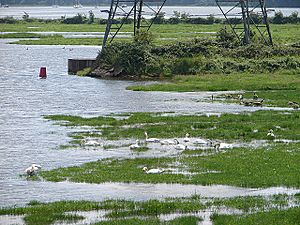Eling and Bury Marshes facts for kids
| Site of Special Scientific Interest | |
 |
|
| Area of Search | Hampshire |
|---|---|
| Interest | Biological |
| Area | 112.3 hectares (277 acres) |
| Notification | 1986 |
| Location map | Magic Map |
Eling and Bury Marshes is a special natural area in Hampshire, England. It covers about 112.3 hectares (277 acres). This area is located between the towns of Totton and Southampton. It is officially recognized as a Site of Special Scientific Interest (SSSI). This means it is protected because of its important plants and animals.
The marshes are also part of bigger protected areas. These include the Solent and Southampton Water Ramsar site, which protects important wetlands. It is also a Special Protection Area for birds. Lastly, it is part of the Solent Maritime Special Area of Conservation, which protects habitats and species.
Contents
What are Eling and Bury Marshes?
Eling and Bury Marshes are made up of two different saltmarshes. A saltmarsh is a coastal wetland area. It gets flooded by the sea's tides. These two marshes are separated by muddy areas called intertidal mudflats. These mudflats are exposed when the tide is low.
Eling Great Marsh
One part is called Eling Great Marsh. This marsh is 'grazed'. This means that animals, like cows or sheep, eat the plants there. Because of this, the plants grow in a very short and dense way. This is called a 'close sward'.
Bury Marsh
The other part is Bury Marsh. This marsh is 'ungrazed'. No animals eat the plants here. Because of this, Bury Marsh has many different kinds of plants. This is known as a 'diverse flora'.
Why are these marshes important?
The entire site is part of Southampton Water. This is a large tidal estuary. An estuary is where a river meets the sea. Southampton Water is very important for many types of birds. Especially, it is a key home for 'waders'. Waders are birds that feed in shallow water or on mudflats. They often have long legs and beaks.

